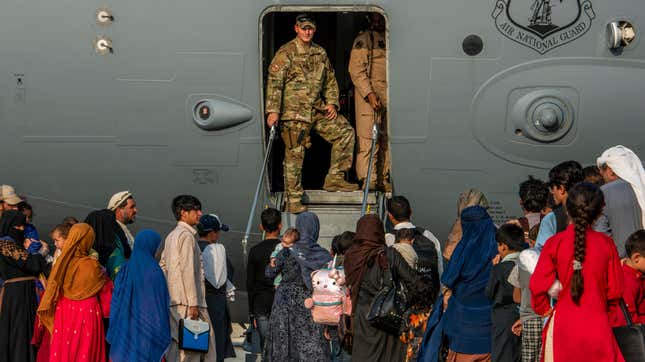
People fleeing Afghanistan following the Taliban’s rapid takeover of the country last week are being housed in conditions U.S. officials are describing as a “living hell”—including suffering through searing temperatures in August in Qatar without any air conditioning.
Axios received a leaked email on Tuesday from a Defense Department official on the ground in Qatar. In it, he recounted the terrible conditions at the Al Udeid Air Base, which the U.S. government is currently using to hold thousands of evacuees fleeing Afghanistan while the Biden administration works on permanent resettlement plans.
The email was sent with the subject line “Dire conditions at Doha,” and was sent to a number of officials at the State Department and the Pentagon, Axios reported. In the email Colin Sullivan, an official at U.S. Central Command, wrote that “a life-threatening humanitarian disaster” was unfolding at the base.
In the email, Sullivan described how the thousands of refugees have inadequate access to sanitation and are suffering in sweltering heat. He included notes from staff on the ground at Al Udeid, who said that with every plane full of additional refugees that comes in, the situation gets direr as resources become more scarce.
“Where the Afghans are housed is a living hell,” one note reads. “Trash, urine, fecal matter, spilled liquids and vomit cover the floors.”
“I spent an hour in there picking up trash ... almost suffocated,” another reads.
Worryingly, the email also details how the base lacks air conditioning for those housed in the hangars at Al Udeid, exposing the refugees to sweltering August heat. Temperatures in Doha reached 103 degrees Fahrenheit (39 degrees Celsius) on Tuesday, and could reach a high of 107 degrees Fahrenheit (42 degrees Celsius) Wednesday. Air temperatures are just one way to measure conditions on the ground—what people might be experiencing depends on a whole host of factors, including wind, sunlight, and humidity. The Earth Wind Map has a measure known as the misery index that includes those factors along with temperatures. It shows that the Middle East is pretty damn miserable right now. On Tuesday, the misery index for Doha shows that it felt like 114 degrees Fahrenheit (46 degrees Celsius)—well over the air temperature high.
Nighttime lows—or perhaps more accurately, “lows”—have provided no relief either. Overnight temperatures are expected to bottom out in the 90s. In a separate report from the Washington Post published this weekend, video shows thousands of people crammed into a huge hangar, the floor crowded with people sitting and lying among their possessions. The Post reported it was still 94 degrees Fahrenheit (34.4 degrees Celsius) outside the hangar that evening, and some refugees held up signs reading “I can’t breathe,” the Post reported.
Officials Axios spoke to with knowledge of the hangars said that they were outfitted just with fans and evaporative cooling machines. “It’s brutally hot,” the official said. “The base is in the middle of a desert. There’s nothing around it. There’s a reason they’re not holding the World Cup in the middle of the summer there.”
The average high temperature for Doha in August is 105 degrees Fahrenheit (41 degrees Celsius), while the average low is a still-sweltering 84 degrees Fahrenheit (29 degrees Celsius). Climate change has made the normally searing region even hotter, pushing temperatures in the region to nearly-unlivable levels. Research has shown that a combination of carbon pollution, warming waters in the Persian Gulf, and the impacts of rapid urban development have made Qatar warm faster than a lot of other places. The country is more than 3.6 degrees Fahrenheit (2 degrees Celsius) hotter than it was in the 1800s. The country has responded with a mass air conditioning effort—including efforts to quite literally air condition the outdoors, especially in anticipation of the World Cup next year.
The Post reported that U.S. officials have moved an additional 3,000 refugee beds to air-conditioned spaces and upped the delivery of water bottles in the hangar, while the Pentagon told Axios it “has taken concrete steps to improve conditions on the ground” and expedite processing for refugees to continue their journey. But the fact that these conditions even existed in the first place speaks to just how unprepared the U.S. was for what happened in Afghanistan last week. In a country that is developing air conditioning techniques for its outdoor stadiums and malls and had to move a major athletic event to the winter to make sure attendees and athletes didn’t suffer and potentially die in the summer heat, it shows an incredible lack of preparation to have to house thousands of people in a facility with no air conditioning.
Climate change is exacerbating crises and affecting refugees all over the world, creating dangerous situations both in their home countries and in the places they’re fleeing to. The conditions in Doha show that even when refugees find a “safe” place, climate change can still make their situation unsafe.
“While not in any way downplaying the conditions in Kabul nor the conditions the Afghanis [sic] are escaping from, the current conditions in Doha are of our own doing,” Sullivan wrote in his email.